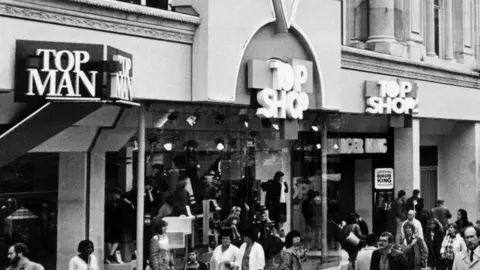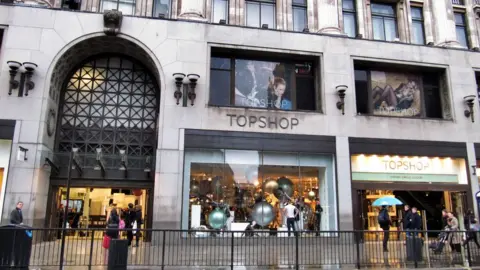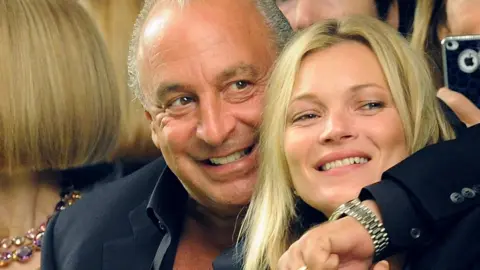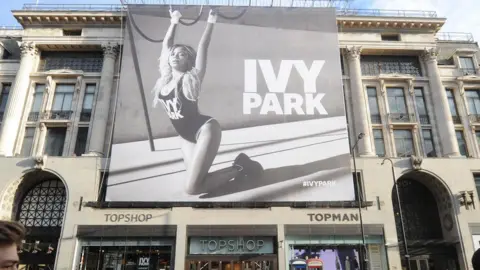A brief history of Topshop: From basement to high-street empire
 Getty Images
Getty ImagesIf you're into high-street fashion, Topshop is a name you're probably familiar with.
It used to be one of the most popular stores in the UK, known for being a great place to buy fashionable, affordable clothes.
But now Arcadia, the company that owns Topshop, is running out of money and could enter administration as soon as today.
Going into administration doesn't necessarily mean all the stores will close, but it might mean closing parts of the company that are losing money.
Lacking a 'relevant connection'
Its problems come after the global pandemic caused problems for all sorts of businesses, but experts don't believe coronavirus is solely to blame for the decline in sales at Topshop.
"If you're going to make a go of retail on the high street, you have to excite people because it's so easy to shop on your phone or tablet," Graham Soult, a retail consultant, tells Radio 1 Newsbeat.
"Topshop and Topman haven't really invested in their stores. They are quite boring and not very exciting places to go."
He says other retailers, like Boohoo and Missguided are doing a better job.
"They really understand their customers and talk their language."
But that wasn't always the case. Here's how the Topshop brand rose from a basement to one of the biggest names in British fashion.
1964: A start in Sheffield
Lets take it back to the beginning.
In 1964, The Beatles were one of the most popular bands in the world and Nelson Mandela was sentenced to life in prison.
It was also the year Topshop was born, it was founded by Raymond Montague Burton and part of The Burton Group.
It started as a small section in the basement of a store in Sheffield called Peter Robinson.
By 1974, Topshop had left the basement and established itself as a stand-alone store, catering to 13-25 year olds.
1978: Boys need fashion too
This was the year Topshop's buddy, Topman, opened stores for the first time.
It specialised in men's fashion and became increasingly popular due to the decline in men's tailoring services.
The first Topman store was in Leeds.
 Getty Images
Getty Images1994: The (huge) flagship store
After nearly three decades of growth, the Topshop flagship store opened in Oxford Circus.
The shop is one of the first things you see when you come out of the Oxford Circus tube station, has a DJ booth, nail bar and even food and drink stalls inside.
In 1997, The Burton group split up and restructured into the Arcadia group, which then purchased other big name stores - such as Miss Selfridge and Wallis.
 Getty Images
Getty Images2002: Philip Green buys Topshop
Along with his wife, Sir Philip Green bought the Arcadia group - and all the shops it owned by then - in 2002 for £850 million.
His high profile collaborations made the brand more popular, and the Kate Moss collection in 2007 was a great example of this.
Hundreds of people queued to buy items the supermodel helped produce when she partnered with Topshop to create a range for the store.
Kate had a close friendship with owner Sir Phillip Green, but the collaboration ended in 2010.
 Getty Images
Getty Images2010: Tax troubles?
Campaigners protested outside several UK Topshop stores, when the then-Prime Minister David Cameron chose Sir Philip to lead a government review on spending.
Protesters believed he wasn't the right man for the job and accused him of tax avoidance.
The flagship store in London had to close for three hours and people even super-glued their hands to the shop windows.
However, it was found that Arcadia had actually paid significant amounts of corporation tax.
2016: Ivy Park drops
Together with Sir Philip, Beyonce founded Ivy Park - a gymwear label named after her daughter Blue Ivy.
On the launch date, thousands tried to buy the items, causing the whole website to crash.
But her partnership with Topshop didn't last long.
 Getty Images
Getty ImagesIn 2018, Beyonce cut ties with the Topshop boss and bought him out of the company.
It happened shortly after he was named in parliament as the man accused by a newspaper of sexual harassment and racial abuse of staff.
He denied the allegations.
2020: Covid creeps in
Coronavirus has hit businesses hard everywhere this year.
Topshop stores across the UK have had to close during lockdown, and Arcadia admitted the virus had "a material impact on trading across our businesses".
More people are shopping online, and while Topshop does have a website it's been criticised for "lagging behind" the digital market, compared to other shops like Zara, Boohoo and Pretty Little Thing.
Now, Arcadia is at risk of collapse, putting over 13,000 jobs at risk.
The group also owns Miss Selfridge, Dorothy Perkins and Burton.
Some stores could close, so for those employed by these companies, it's an anxious waiting game.


